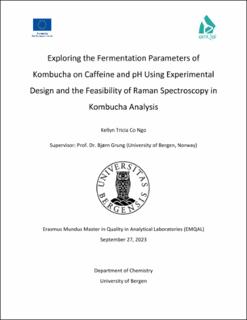| dc.description.abstract | Kombucha shows promising growth potential due to its claimed health benefits. Through an experimental design, the impact of the fermentation parameters on color and appearance, pH and caffeine content was further understood with sample points of Day 1, 7, 10 and 14. Steeping time, steeping temperature, tea strength, starter-to-tea ratio, tea-to-liquid ratio, sugar content, and beaker size were employed on a 27-4 design and its corresponding full fold-over. In addition, this study explores the feasibility of Raman spectroscopy for understanding and predicting kombucha behavior and validates an HPLC method for caffeine content analysis. As expected during fermentation processes, pH declines rapidly in the first few days and gradually decreases later on. Identified significant variables vary among the sampling days, such as tea strength, sugar content and beaker size. The starter-to-tea ratio remained a significant parameter in the course of the fermentation. In contrast, caffeine content was mostly consistent or decreased during the fermentation period except for a few experiments. Several of the identified parameters and interactions affect caffeine content; for example, steeping temperature, starter-to-tea ratio, tea strength, sugar content and interactions 1x5 (AxE) and 1x4 (AxD). Savitzky-Golay 1st derivative, window 11, and at 2nd degree achieved modest separation of Set 3 from Sets 1 and 2 using PCA; however caffeine and pH were not the cause of the separation according to PLS. Unfortunately, Raman proved insensitive to kombucha's caffeine content and pH through spiking studies. Overall, there is still a lot of work that can be done with this study. Execution of the experimental design, investigation of the microbial composition, and further exploration of the use of Raman spectroscopy are few of the recommendations for this study. Despite this, the study can serve as a foundation for future kombucha studies exploring the fermentation parameters and its effect on kombucha’s chemical composition through experimental design. | |
